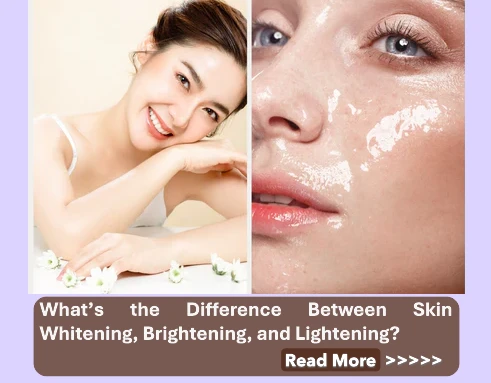What’s the Difference Between Skin Whitening, Brightening, and Lightening? Clarifying Common Skincare Terms for a Healthier Complexion
What’s the Difference Between Skin Whitening, Brightening, and Lightening? Clarifying Common Skincare Terms for a Healthier Complexion
In the world of skincare, the terms skin whitening, skin brightening, and skin lightening are often used interchangeably—but they don’t mean the same thing. Understanding the difference between these terms is essential for choosing the right products or treatments based on your unique skin goals. Here's a clear explanation of each, how they work, and what to consider when using them.
1. Skin Brightening: Enhancing Radiance
Skin brightening refers to the process of restoring the skin’s natural glow by improving texture, hydration, and tone. This method focuses on removing dullness, increasing cell turnover, and boosting skin clarity.
Common Goals:
-
Improve skin radiance
-
Reduce dull or tired appearance
-
Promote even tone and smooth texture
Common Ingredients:
-
Vitamin C – Antioxidant that improves radiance
-
Niacinamide – Brightens and strengthens the skin barrier
-
Alpha hydroxy acids (AHAs) – Promote exfoliation for glowing skin
Brightening products do not change your skin color; they simply reveal a more vibrant version of your natural complexion.
2. Skin Lightening: Reducing Dark Spots and Pigmentation
Skin lightening targets specific areas of hyperpigmentation, such as sunspots, age spots, acne scars, and melasma. The goal is to reduce melanin production in uneven patches and achieve a more even skin tone—not to bleach the skin overall.
Common Goals:
-
Fade dark spots and discoloration
-
Treat post-inflammatory hyperpigmentation (PIH)
-
Balance skin tone
Common Ingredients:
-
Kojic acid – Inhibits melanin production
-
Arbutin – Natural skin lightener
-
Licorice extract – Soothes and lightens dark patches
-
Hydroquinone (prescription-based) – Powerful lightening agent (with caution)
Skin lightening is typically used for targeted treatment, not full-face bleaching.
3. Skin Whitening: Altering Natural Skin Tone
Skin whitening refers to attempts to alter the skin’s natural color and make it several shades lighter, often through more aggressive methods or unregulated products. This practice is controversial and, in some cases, unsafe.
Common Goals:
-
Achieve a fairer complexion overall
-
Lighten skin tone beyond natural baseline
Common Ingredients:
-
High-dose hydroquinone, steroids, or glutathione (oral or injectable)
-
Many skin whitening products are not FDA-approved and may contain harmful substances like mercury
Skin whitening is not recommended by dermatologists, as it can damage the skin barrier, cause long-term sensitivity, or lead to serious health issues.
Final Thoughts: Choosing What’s Right for You
The terms whitening, brightening, and lightening may sound similar, but they have different intentions and outcomes:
-
Brightening = Glow and radiance
-
Lightening = Reduce pigmentation and even skin tone
-
Whitening = Change natural skin color (often risky)
Understanding these differences helps you make informed, safe decisions about your skincare. For the healthiest results, always opt for dermatologist-approved, non-toxic products and focus on enhancing your natural beauty—not changing it.

Related Blog
What Causes Oily Skin and Can It Be Managed Naturally? Exploring Root Causes and Gentle Solutions
Aug 2, 2025 by Admin
General
What Are the Signs That You Have Sensitive Skin? Key Symptoms to Help You Identify This Delicate Skin Type
Aug 1, 2025 by Admin
General